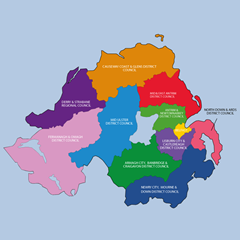Local government elections
 Northern Ireland’s most significant council elections for 40 years will take place on 22 May. agendaNi previews the main changes.
Northern Ireland’s most significant council elections for 40 years will take place on 22 May. agendaNi previews the main changes.
The elections to the 11 new councils on 22 May will be the most significant in forty years and will have a much greater day-to-day impact than the European Parliament elections to be held on the same day. Each European Parliament candidate will effectively be leading their party’s council campaign as they canvass across the province.
A total of 462 councillors will be elected, down from the current 582. The basic unit for electing councillors is a district electoral area (DEA), of which there will be 80: ten in Belfast due to its larger population and seven for each of the other councils.
DEAs are not rigid divisions as councillors often take up cases from outside their specific area. Their names are taken from local towns and other features such as the Mournes, Ards Peninsula and Glens of Antrim. More abstracts names include Airport (around Aldergrove), Titanic (in east Belfast) and the Moor (Derry city centre and the Bogside).
The District Electoral Area Commissioner, Dick Mackenzie, tried to use clear physical features as boundaries and also include complete settlements within a DEA. This was not always possible; legislation for the process meant that each DEA had to include not less than five and not more than seven wards.
Belfast’s population will expand from 280,000 to 333,000 by taking in parts of Lisburn, Castlereagh and North Down. This will make it by far the largest council area and, accordingly, it will have 60 councillors.
Armagh, Banbridge and Craigavon and Newry, Mourne and Down will be second and third respectively in the population rankings (see table). Each of these councils will have 41 members.
All other councils will have 40 members and most will have 130,000-140,000 residents. Fermanagh and Omagh will have the smallest population (113,000) but the largest area. By comparison, the smallest council population at present is in Moyle: 17,000.
It is hard to draw comparisons with the 2011 election as the number of councillors is going down by almost a fifth. Last time round, the numbers of seats by party were as follows.
| Party etc | Seats |
| DUP | 175 |
| Sinn Féin | 138 |
| UUP | 99 |
| SDLP | 87 |
| Alliance | 44 |
| Minor parties | 12 |
| Independents | 27 |
Based on those statistics alone, the results for 462 seats would have been as follows. However, the number of independent and minor party councillors may be smaller as it will be harder for them to reach the new quotas.
| Party etc | Seats |
| DUP | 139 |
| Sinn Féin | 110 |
| UUP | 79 |
| SDLP | 69 |
| Alliance | 35 |
| Minor parties | 10 |
| Independents | 21 |
Councils will be required make audio recordings of meetings in order to improve their accountability to the public.
Decisions will generally be passed by a simple majority with the chair having the casting vote. Standing orders will specify some situations where qualified majority voting must be used. The qualified majority has been set at 80 per cent, meaning that 20 per cent of councillors could form a ‘blocking minority’.
If a decision went through by qualified majority, 15 per cent of councillors could request that it be reconsidered. This would be permitted if the decision was “not arrived at after a proper consideration of the relevant facts and issues” or if it would “disproportionately affect adversely” any group of people in the district. The most confusing aspect will be that the old councils will continue to work until April 2015 as the new councils prepare to take over.
Several councillors will, in fact, be sitting on both councils. Over the last year, the main parties have been retiring long-serving councillors and co-opting new ones in their place. They have used their short terms in office to build up their profile and many of them will be elected to the new councils in May.
The ending of dual mandates will mean that party leaders on councils will be influential in their own right. The average number of constituents per councillor will rise from 3,111 to 3,919.
The current reforms are the fourth significant change in local government since the modern system was established in 1898. A proportional representation system was introduced across Ireland in 1919 but Northern Ireland reverted to first-past-the-post in 1929 under the old Stormont administration.
Proportional representation was reintroduced in 1973, when the current councils were established, after criticisms made by the Cameron Commission’s inquiry into discrimination and the Macrory review of local government.
| Community background (%) | ||||
| Name | Population | Protestant | Catholic | Other |
| Antrim and Newtownabbey | 138,567 | 61 | 30 | 9 |
| Armagh, Banbridge & Craigavon | 199,693 | 52 | 43 | 5 |
| Belfast | 333,871 | 42 | 49 | 9 |
| Causeway Coast & Glens | 140,877 | 55 | 40 | 5 |
| Derry & Strabane | 147,720 | 25 | 72 | 3 |
| Fermanagh & Omagh | 113,161 | 33 | 64 | 3 |
| Lisburn & Castlereagh | 134,841 | 67 | 24 | 9 |
| Mid & East Antrim | 135,338 | 73 | 19 | 8 |
| Mid Ulster | 138,590 | 33 | 64 | 3 |
| Newry, Mourne & Down | 171,533 | 24 | 72 | 4 |
| North Down & Ards | 156,672 | 75 | 13 | 12 |





